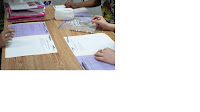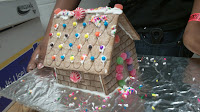There is not a set curriculum for this class. Basically I can do whatever I feel is necessary. Going into this, I knew that I did not want it to just be another study hall for these students to work on homework. Although the students are occasionally given time to finish assignments from other classes.
We spend Mondays looking over all their grades from all their classes and setting goals on how to improve and bring up failing or low grades. This mostly means getting the students to go into tutorials to turn missing assignments or make-up failing ones. Easier said than done. At the same time, I am encouraging and trying to instill into the students the habit of being proactive, planning ahead for major projects and tests.
They then spend Fridays on Cognitive Tutor. For some reason, Carnegie Learning and Cognitive Tutor have a reputation in my district as being a “remedial” curriculum for those who are not successful in the regular setting. Boy is it far from that! Just ask my advanced algebra students. Carnegie Learning and CT make the students think and reason through math concepts as well as apply them to real-life settings. Nothing is dumbed down.
My math enrichment kiddos spend the rest of the week supporting what is being taught in their pre-algebra classes. Sometimes I set the foundation for what’s to come. Other times I reinforce what their pre-algebra teachers are doing. Whether I’m pre-teaching or re-teaching, I try to make the lessons and activities hands-on and engaging, many times non-traditional.
My pre-algebra students recently finished a two-month long study over geometry. Over the holiday break, I kept wondering what I was going to do differently with my math enrichment students. One of my family’s favorite traditions is building gingerbread houses. This became the inspiration for my ME class. The best part? Gingerbread house kits are on clearance after the holidays!
My student teacher and I divided the class into groups of 2-3 students each. Each group received their own gingerbread house kit. They spent the next month or so naming shapes, measuring (a lost skill for most people) the dimensions of the cookies and calculating their perimeters, areas, and volumes. It was so nice to see the students come to class every day excited about doing math! To top it off, they cooperatively worked together, helping one another and being supportive. Each person had his/her own strengths to offer to their group. “Riley” is your typical passive student who won’t give you trouble but at the same time will not put any effort into learning. During this unit, he “woke up” and came out of his shell. One day I overheard him explain to his group why they were only given three of the walls (cookies) instead of all six. I love it when my students take leadership roles in class!
Overall, the GEOMETRY-bread House unit was a success! I can’t wait to implement it again next year.














1 comment:
What a fun project! You're students are very lucky to have such an innovative teacher!
Post a Comment